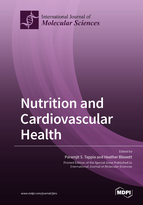Nutrition and Cardiovascular Health
A special issue of International Journal of Molecular Sciences (ISSN 1422-0067). This special issue belongs to the section "Bioactives and Nutraceuticals".
Deadline for manuscript submissions: closed (31 July 2019) | Viewed by 145688
Special Issue Editors
Interests: cardiovascular disease; diabetes; nutrition; early-stage lung cancer
Special Issues, Collections and Topics in MDPI journals
Special Issue Information
Dear Colleagues,
There is unequivocal experimental, epidemiological and clinical evidence demonstrating a correlation between diet and increased risk of cardiovascular disease (CVD). While nutritionally-poor diets can have a significant negative impact on cardiovascular health, dietary interventions with specific nutrients and/or functional foods are considered cost-effective and efficient components of prevention strategies. It has been estimated that nutritional factors may be responsible for approximately 40% of all CVD. Indeed, in one of the seminal studies conducted on modifiable risk factors and heart health (the INTERHEART study), >90% of all myocardial infarctions were attributed to preventable environmental factors with nutrition identified as one of the important determinants of CVD. There is increasing public interest and scientific investigation into establishing dietary approaches that can be undertaken for the prevention and treatment of CVD. This Special Issue provides an insight into the influential role of nutrition and dietary habits on cardiovascular health and disease, as well as their mechanisms of therapeutic and preventive action. In view of the impact of the nutritional experience of the developing fetus, the role of epigenetics and maternal nutrition on the risk of developing cardiovascular complications in later life will also be highlighted.
Dr. Paramjit S. Tappia
Dr. Heather Blewett
Guest Editors
Manuscript Submission Information
Manuscripts should be submitted online at www.mdpi.com by registering and logging in to this website. Once you are registered, click here to go to the submission form. Manuscripts can be submitted until the deadline. All submissions that pass pre-check are peer-reviewed. Accepted papers will be published continuously in the journal (as soon as accepted) and will be listed together on the special issue website. Research articles, review articles as well as short communications are invited. For planned papers, a title and short abstract (about 100 words) can be sent to the Editorial Office for announcement on this website.
Submitted manuscripts should not have been published previously, nor be under consideration for publication elsewhere (except conference proceedings papers). All manuscripts are thoroughly refereed through a single-blind peer-review process. A guide for authors and other relevant information for submission of manuscripts is available on the Instructions for Authors page. International Journal of Molecular Sciences is an international peer-reviewed open access semimonthly journal published by MDPI.
Please visit the Instructions for Authors page before submitting a manuscript. There is an Article Processing Charge (APC) for publication in this open access journal. For details about the APC please see here. Submitted papers should be well formatted and use good English. Authors may use MDPI's English editing service prior to publication or during author revisions.
Keywords
- Diet
- Cardiovascular disease
- Nutrition
- Hypertension
- Cholesterol
- Myocardial infarction
- Saturated fat
- Developmental origins of health and disease
- Anti-oxidants







